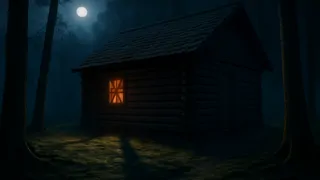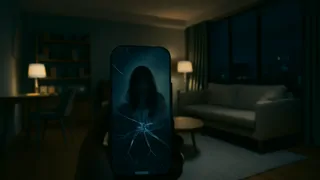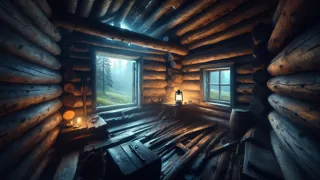Introduction
Claire pressed her palm against the worn wooden door, its paint chipped and flaked from decades of storm, sun, and snow. Inside, the cabin was dim, the air thick with the earthy scent of damp wood and pine needles that had drifted in on the breeze. She had found this place online, an old hunting lodge in the remotest corner of the northern forest, far from the hum of traffic and judgmental eyes. The loneliness had called to her after the city felt too close, her breath too short, the deadlines and expectations too suffocating. Here, she hoped, she could write freely, find the clarity she’d lost months ago. No internet, no cell signal—just her notebook, a pen, and untamed wilderness.
At the far end of the main room, a window had been crudely nailed shut with wide planks of weathered pine, darkened by mold and age. The boards blocked the only view of the forest beyond, as though something outside had forced the cabin’s previous occupants to seal themselves in. Despite the gloom, Claire felt drawn to it, the silence around those boards heavier than any other corner of the cabin. She shivered, stepping closer. The nails were rusted, and the wood creaked under her fingertips. Why would anyone board up a window and then leave the cabin behind? She turned away, flicking on a small lamp to chase away gathering shadows. The wind picked up outside, rattling the shutters, and for a moment, Claire thought she heard a soft knock on the window behind the boards. She froze. The knock came again—deliberate, slow, almost curious.
Her heart pounded in her chest, doubt and panic surging. This place was supposed to be empty. No caretaker, no passersby. She rationalized it must be an animal or an echo of the wind. Yet the sound felt personal, as if someone was trying to speak from the other side of the wood. Shaking, she carefully unpacked her bag, setting out a blanket, a stack of notebooks, and her laptop—useless in this digital void but comforting nonetheless. With every creak in the floorboards and gust against the door, Claire’s tension coiled tighter. She lit a second lamp and placed it on the table opposite the boarded window. Shadows danced between the planks, and in that lantern glow, the darkness seemed alive.
Dinner was canned soup and stale crackers, eaten in silence as the wind screamed outside. Rain tapped the roof in uneven rhythms. Claire forced herself to write: the words were stilted, each sentence a battle. Storm and isolation took hold of her narrative. She tried to focus on the cabin’s history—log entries claim it was built in the 1920s by a family who vanished one winter, citing nothing but “unrite sounds.” Those rumors had lured her here more than anything. It was too late now to turn back. She closed her notebook and leaned back in her chair, staring at the boarded window as if it might reveal its secret to her gaze. After a long moment, she blinked. Then there it was again—a faint tapping, deliberate, rhythmic. Tap… tap… tap.
Lightning flashed through a crack in the north wall, followed by thunder that shook the floor. In that strobe of brilliance, Claire thought she saw movement behind the boards—something thin, elongated, skittering in the gloom. She gasped, heart seizing. The boards hadn’t shifted, but in that flash, something had slid past the sliver of broken glass at the top. Was it a branch? An animal’s paw? The house was locked down, yet she knew with a preternatural certainty that this cabin’s boarded window hid far more than rotting wood and rusted nails. As the storm crashed overhead and the night pressed in closer, Claire realized that whatever lived outside wasn’t bound by simple logic. They were watching. And they wanted in.
The Crack in Solitude
Claire spent the next morning exploring the cabin and its immediate grounds. Outside, past the rotting steps and underbrush, the forest loomed tall and silent. Moss dripped from the pines, and an uneasy stillness lay under the canopy. She climbed an embankment by the back porch, discovering a small clearing where footprints—human prints—had been trampled into the soft earth. They were fresh, too deep to be just past debris; someone had approached the cabin recently. Fear trickled into Claire’s mind, but so did stubborn determination. She scribbled notes: ‘‘Signs of a visitor. No tracks beyond the clearing.’’ Whatever timid pretense of solitude she’d imagined was gone.

Inside, the boarded window felt like a silent sentinel. Claire removed one board to investigate the original glass, only to find it shattered, shards left behind like jagged teeth. She wore gloves and gathered the fragments in a cloth. Why seal off a broken window instead of replacing it? Each clue seemed to deepen the mystery until Claire nearly believed the old rumors: that the forest here never let its victims go.
Weather reports on the one battered radio indicated the storm would last another day. No power, no phone. She filled her water jug from a tarnished sink and stretched out on a narrow bed, but exhaustion wouldn’t come. Sleep was dangerous when something pressed against the other side of those boards. She lit candles and wrote every sound into her notebook—each pop of settling wood, each gust against the eaves—and realized she’d recorded dozens of knocks and taps just since morning. Something was circling the cabin, testing her, probing her. Was it an animal? A person? Or something else entirely?
Night fell quickly once the sky opened, and Claire fastened extra nails to the window frame. Then she sat in the chair by the fireplace, cradling a blanket around her shoulders. The storm’s howl began anew. She stared hard at the boarded window until her eyes stung. Then, unmistakable: a single, slow knock. Knock. A pause. Knock…knock. On the wood itself, low and measured. Something or someone was calling her. Claire pressed her ear to the door in search of an answer, but the cabin groaned only in response. She pulled away, her pulse hammering.
She wrote: ‘‘If you’re out there, I can’t hear you. If something’s behind this, knock louder or be gone.’’ And for a moment, the storm seemed to listen. The knocks ceased entirely. Silence swallowed the cabin. Claire drifted into uneasy dreams, where shadowy figures watched her from beyond broken glass.
By dawn, the storm’s fury had passed. Claire awoke to a hush, the air cool and damp. She hurried to the window, yanked off all the boards, and peered into the still forest. Nothing. Sunlight filtered through budding leaves. The broken glass lay on the sill, half-buried in soil. She breathed deeply and resolved to leave at first light, vowing never to speak of what she heard. But as she turned away, something caught her eye: small letters carved crudely into the wood of the frame, previously hidden by planks. C-O-M-E H-O-M-E.
Her breath caught. That carving wasn’t fresh; the letters were old, the cuts dried over time. Yet the message remained chillingly clear. ‘‘Come home.’’ Claire ran her fingertips over the grooves, heart sinking with a dread she couldn’t name.
She packed and called out into the empty room, ‘‘Who are you?’’ Only silence answered. Then behind her, unmistakable in the cracked glass of the cabin’s front door, a reflection: her own face, pale and haggard—but another pair of eyes glinted behind her, alive with intent. She spun, and the cabin was empty.
Claire fled into the forest, leaving boots, luggage, and notebook behind. She never found the tracks again. And when authorities later pried off the boards, they discovered no evidence of forced entry, only the whisper of those carved words. Claire never returned, but sometimes at night, strangers in distant towns claim they hear soft knocks coming through their windows.
Eerie Encounters
Weeks passed after Claire’s escape, yet the memory of the boarded window haunted her. She tried to return to her apartment, circle back to her writing, but each time she closed her eyes, she saw that message carved in wood. ‘‘Come home.’’ Her therapist suggested post-traumatic stress, that her mind conjured illusions in the face of fear. Claire nodded but knew something more had occurred—something impossible.

In an effort to reclaim her mind, she booked a stay at a small bed-and-breakfast in the same region, hoping daylight and other people would exorcise her panic. The host was kind—an elderly woman named Martha—who served fresh bread and told tales of the surrounding woods. But when Claire mentioned the boarded cabin, Martha’s face went ashen. ‘‘That place has been empty for decades,’’ she whispered, wiping her hands on her apron. ‘‘They say the original owner died in the storm, and no one’s brave enough to live there. Not since the children vanished.’’
Children vanished. Claire felt a cold spike in her chest. ‘‘Children?’’ she asked. Martha nodded. ‘‘A brother and sister. Folks claimed they heard a tapping from inside the cabin, like someone calling them through broken glass. The kids sneaked out at night, vanished into the trees. The search parties found no trace. Some say the forest claimed them; others think they found shelter somewhere else. But the parents kept that window boarded, hoping to listen for the children’s calls. Eventually they left, and the cabin was deserted.’’
Claire left breakfast in a daze. A history of grief tied to that window, a place where longing took form in knocks and whispers. She felt sick as Martha’s words echoed in her mind. All along, Claire had believed herself alone. Instead, she’d fallen into the cabin’s tragic legacy—a siren’s call of longing and loss. How many others had heard those taps and scratches? How many had answered?
Determined to confront her fear, Claire returned at dusk to the cabin’s clearing. No storm tonight, just a full moon brushing the treetops. The boarded window loomed. She approached, carrying a small lantern. Her legs trembled, but she steeled herself: ‘‘I’m not you,’’ she said aloud. ‘‘I won’t vanish. I won’t be lost.’’ She traced her fingers around the frame where ‘‘COME HOME’’ remained carved. Then she touched the boards—solid, old oak. She tried pushing one plank sideways but it held firm. Tears came unbidden. She whispered, ‘‘I’m leaving.’’
In reply, a soft patter: single knocks near her temple. Claire jerked back, looked around. Nothing but shadows. The cabin door creaked. She shifted her lantern; the amber light flickered across the glass shards. And then, oh God, reflected in that jagged mirror, she saw a small girl peering from inside, pale-faced, hair in tangled braids. Claire stifled a scream. The girl tilted her head and knocked again. Knock…knock.
Claire turned away, sprinted for her car parked on the muddy track. Her breaths came in quick bursts. As she reached the driver’s door, she glanced over her shoulder. In the moonlight behind the cabin, several figures stood mortal still—two children, a boy and a girl, pale in the lamp’s glow. Their lips parted as though to speak. They raised a hand in farewell or command. Then the boarded window sprang open. The planks snapped off, driven inward by a force Claire couldn’t explain. The glass shards fell like rain at her feet. Behind the broken frame, nothing but empty darkness. She slammed her door and raced away.
From the road, she watched the cabin recede into the forest. No lights, no movement. Only the echo of those taps, fading with distance. By sunrise, the cabin was gone entirely—no trace of wood or structure, as though it had never existed. In its place was a tidy patch of moss and saplings.
Claire never returned to the region. But late at night in her dreams, she hears taps on her window—slow, insistent, longing to be heard again.
Revelations
Months later, Claire sat in her new apartment, staring at the blank page on her laptop. Writer’s block persisted, the horror of that night still lodged in her mind. She decided to revisit every detail: photos from her phone, notes in her journal. That’s when she noticed something she’d overlooked: timestamps on her cabin snapshots were inconsistent. Several were set to 12:00 a.m. or 12:00 p.m., despite her always checking the clock before each shot. More unsettling, the photos she took while inside the cabin showed subtle differences: in some, the furniture arrangement was slightly altered; in others, shadows fell at angles that didn’t match the lantern’s position.

On a hunch, Claire loaded the images onto her TV and enlarged them. In one photo of the boarded window just before sunrise, she saw not her own reflection but a woman’s silhouette standing behind her, visible through the sliver of broken glass. Claire blinked. The timestamp read 3:14 p.m., though it was pitch dark outside. Who was that figure? She scanned more images: the same woman in her bed behind the camera, hair pulled back, wearing an old-fashioned nightgown. The face was obscured, but the posture matched the girl with braids.
Her pulse raced as she cross-checked with Martha’s description of the vanished siblings. The boy and girl had never been found. Legend says they disappeared in a single night, and their mother, driven to madness, sealed the window to trap their voices inside, then vanished too. Claire realized in horror that the woman in her photos could only be that mother, eternally searching. And she’d been photographing the past as well as the present.
Claire posted the images online in a writer’s forum, asking for help. The responses flooded in: some claimed supernatural interference, others insisted it was a digital glitch. But one stranger emailed her directly: ‘‘I grew up nearby. That cabin isn’t on any official map. People report seeing it at odd times, but it never stays. It drifts, appears to those who need refuge—until grief finds them. You were never alone, Claire. The place called you home to join its legacy.’’
Her breath caught. The screen before her glowed with that ominous explanation, and she realized the final truth: the cabin wasn’t abandoned—it was a door. A doorway between worlds warped by sorrow. She had thought herself the investigator, the writer, but she’d been the one studied. The boards hadn’t kept something out; they’d kept her in. And when she fled, she became part of the tale, another chapter in an unending story of longing and loss.
She looked out her window at the city lights, feeling the weight of unseen watchers pressing close. Her phone buzzed with a notification: someone tagged her in a photo from last night’s post. She opened it. There, standing behind her desk in her apartment, was the woman in the nightgown, pale as moonlight, braids loose, reaching toward Claire with a desperate smile.
Claire dropped her phone. The screen cracked. In the shattered glass, she saw not her reflection but empty boards, wood blotting out the world. And then the slow, unmistakable knock: tap…tap…tap.
Conclusion
Claire never published the story she intended. Instead, she set aside her laptop and moved across the country, desperate to escape the echoes that had followed her home. But the knocks came still—faint at first, then louder, as if impatience had grown. At night she hears them on her bedroom window, upstairs in her new house. Tap… tap… tap. Every time, she braces against the glass and whispers, “I’m not coming back.” Yet the tapping persists, insistent as a heartbeat longing for release. And sometimes, deep in the house, she swears she hears fingers scraping at the boards of a window that doesn’t exist. Even now, Claire wonders if she escaped at all—or if she’s merely another board in that cabin’s story, biding her time until the next storm.


















